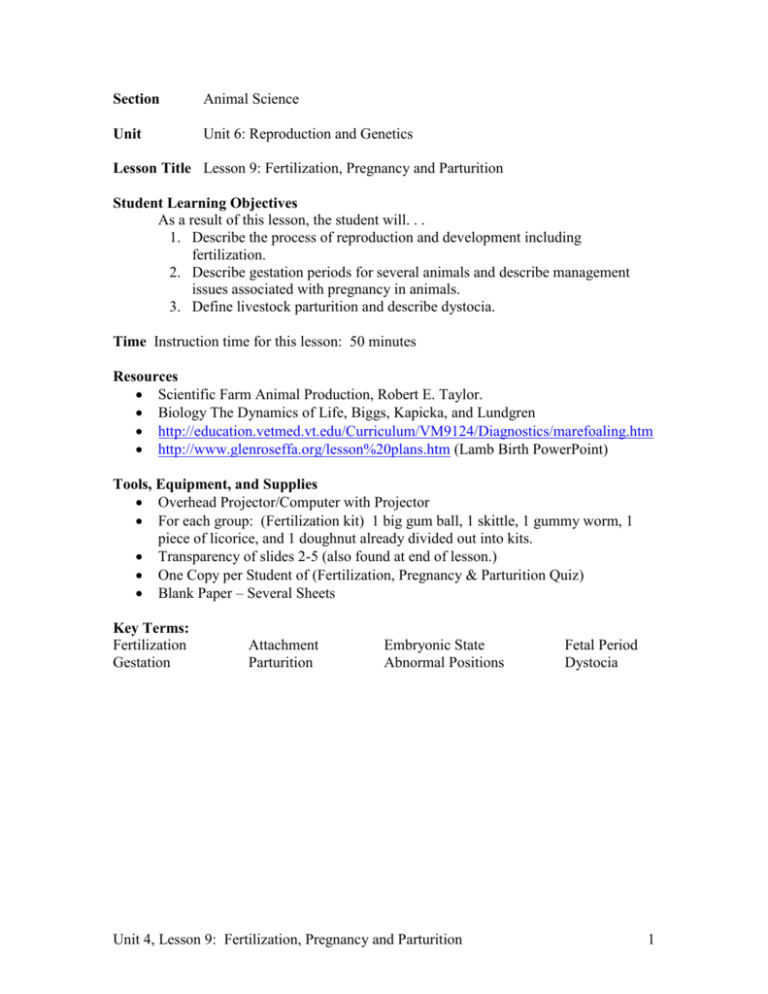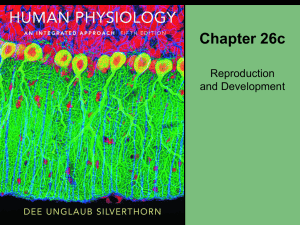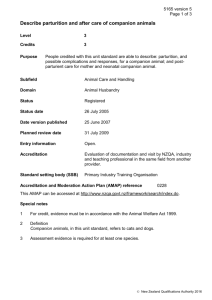Colorado Agriscience Curriculum Development
advertisement

Section Animal Science Unit Unit 6: Reproduction and Genetics Lesson Title Lesson 9: Fertilization, Pregnancy and Parturition Student Learning Objectives As a result of this lesson, the student will. . . 1. Describe the process of reproduction and development including fertilization. 2. Describe gestation periods for several animals and describe management issues associated with pregnancy in animals. 3. Define livestock parturition and describe dystocia. Time Instruction time for this lesson: 50 minutes Resources Scientific Farm Animal Production, Robert E. Taylor. Biology The Dynamics of Life, Biggs, Kapicka, and Lundgren http://education.vetmed.vt.edu/Curriculum/VM9124/Diagnostics/marefoaling.htm http://www.glenroseffa.org/lesson%20plans.htm (Lamb Birth PowerPoint) Tools, Equipment, and Supplies Overhead Projector/Computer with Projector For each group: (Fertilization kit) 1 big gum ball, 1 skittle, 1 gummy worm, 1 piece of licorice, and 1 doughnut already divided out into kits. Transparency of slides 2-5 (also found at end of lesson.) One Copy per Student of (Fertilization, Pregnancy & Parturition Quiz) Blank Paper – Several Sheets Key Terms: Fertilization Gestation Attachment Parturition Embryonic State Abnormal Positions Unit 4, Lesson 9: Fertilization, Pregnancy and Parturition Fetal Period Dystocia 1 Interest Approach To begin how many of you know exactly how fertilization takes place? Not many will be able to answer this question. That’s what I thought, so today I am going to show you through a short activity and then a lesson for the more technical information. When I say go, I need you to divide into groups of three. Then I need one person from each group to come to the front and grab a fertilization kit. You have 30 seconds, go. Now that you are in your groups and have a fertilization kit, let me explain what each item is. (It would be a good idea to create this list on the board.) The gumball is an ovary, the skittle is an egg, the gummy worm is a sperm, the licorice is a fallopian tube, and the doughnut is the uterus. Set the ovary to the left side. Place the licorice facing diagonally down towards the right. Finally place the doughnut on the other end of the licorice. This is your reproductive tract. Now tell me what each piece of food represents. (Erase the list on the board.) Wait until you get the right answer. You may have to prompt them until they get it right. Now you have the parts down you need to fertilize an egg. Place the egg up by the ovary. Place the sperm down by the uterus. The ovary needs to release the egg and have it float down (beside the fallopian tube). The sperm needs to swim through the uterus and up the fallopian tube. The sperm and egg then unite in the fallopian tube and both need to float down to the uterus and attach themselves to the inside of the uterus for further development of the embryo and later fetus. Walk around the room as you explain the process. Make sure everyone is doing it right. You may have to repeat the process twice for students to grasp it. Now in order to get points for this activity each group must go through the entire process and explain it to me in detail. Have every group show you they know what you have just done. Unit 4, Lesson 9: Fertilization, Pregnancy and Parturition 2 Summary of Content and Teaching Strategies Objective 1. Describe the process of reproduction and development including fertilization. Now we are going to explore the technical process of fertilization. Show and review Slide 2, which contains this information. I. Stages of Prenatal Development 1. Fertilization – When the sperm and egg unite. When fertilization occurs, cell division occurs. It starts with 2, 4, 6, and 8 and so on. 2. Attachment – The embryo that has gone through much cell division attaches itself to the uterus for further development. 3. Embryonic Stage – The period when body parts and organs start to form. The length of time differs between species 4. Fetal Period – Period that lasts until birth is mainly a time when body parts and organs mature. When I say go, divide into pairs and discuss the difference between the embryonic stage and the fetal period. Be ready to share your answers in 1 minute. Go. Ask for two or three groups to share. Students should point out that the embryonic Stage is a short time when organs start to form. The fetal period lasts from that point until parturition. Objective 2. Describe gestation periods for several animals and describe management issues associated with pregnancy in animals. Show and review slide 3-4, which contains this information. II. Gestation and Gestation Periods for Different Species 1. Gestation – Length of Pregnancy 2. Gestation time: Human: 253-303 Days Cow: 285 Days Ewe: 147 Days Mare: 336 Days Sow: 114 Days 3. The fetus develops in uterus, most of growth is in the last 1/3 of gestation. 4. Umbilical cord connects the navel to the placenta, where food, oxygen and wastes are exchanged. Now that we know what fertilization and gestation are, what do you guys think we are going to go over next? Wait for the answer birth or parturition. Correct, birth. Or what we like to call it, parturition. Unit 4, Lesson 9: Fertilization, Pregnancy and Parturition 3 Objective 3. Define livestock parturition and describe dystocia. Show and Review slide 5. III. Parturition and Problems with Parturition 1. Parturition – Signals the end of gestation. The process is started by the release of cortisol. This release causes progesterone levels to decline and estrogen, prostaglandin, and oxytocin to increase. All these hormonal changes cause relaxation of the cervix and contractions to occur. These events allow for the fetus to be born outside the body. 2. Abnormal positions (Dystocia) – Piglets don’t assume any particular position during birth and it doesn’t seem to affect the ease of birth. However calves, lambs and foals may present themselves in abnormal positions. The next slide shows normal and abnormal positions. Show slide 6. Have discussions over each position presented and exactly why each is difficult. Also discuss how poultry birth is completely different in that the egg is expelled outside the animal and then the chick is born outside the body. Starting with slide 8, the birth of twins is documented in pictures with brief descriptions. This is a good way to tie in some of the terminology and ideas that have been taught today. The slide show is slides 8-19 Review/Summary Use a Cartographer Moment. Show student how to web the information taught today. Have them draw three circles representing fertilization, gestation, and parturition. Then have them branch out the details about each. Have them make sure to do a good job of writing down all details in order to study for the assessment. After giving students a few minutes to work, you might ask one student to share theirs on the board so students can check their work. Unit 4, Lesson 9: Fertilization, Pregnancy and Parturition 4 Application Extended Classroom Activity: Have students look up other parturition problems presented at birth in other texts or on the internet. Have them bring pictures to class tomorrow so the class can discuss the difficulty of each found position. FFA Activity On a CDE or Convention trip schedule a tour at a local ranch. Have the rancher discuss with students the parturition process and the problems that he has had. Ask him how he managed the problem. In addition, students could interview a large animal veterinarian who has dealt with various problems too. SAE Activity Remind students who have livestock SAE’s that they may run across similar problems at one point. Have them make a list of all tools needed to help them through an abnormal presentation. Then they could take inventory of what they have at home to find out if they are prepared. Evaluation Give students a copy of the fertilization, pregnancy and parturition quiz. Have them take the quiz silently, then pair up with someone else and compare / check answers with their notes. After 3-4 more minutes, go over answers with the whole class to ensure understanding. Answers to Assessment 1. 2. 3. 4. B A C An egg is released from the ovary. The sperm swim up the tract to the fallopian tube. The egg and sperm meet and are united in the fallopian tube. Fertilization is complete. 5. Feet and head first. 6. Could be anything but feet and head first. Unit 4, Lesson 9: Fertilization, Pregnancy and Parturition 5 Lesson 9 Quiz Fertilization, Pregnancy and Parturition Quiz 1. The union of sperm and egg is called A. Parturition B. Fertilization C. Gestation 2. The process of giving birth is called A. Parturition B. Fertilization C. Gestation 3. The length of time a fetus matures is called A. Parturition B. Fertilization C. Gestation 4. Describe how fertilization happens in the female reproductive tract in detail. 5. Describe normal presentation of a foal. 6. Name three abnormal birth presentations. Unit 4, Lesson 9: Fertilization, Pregnancy and Parturition 6







